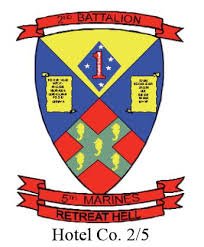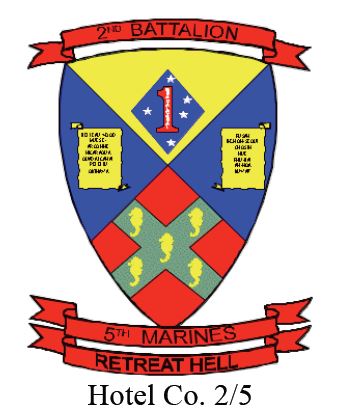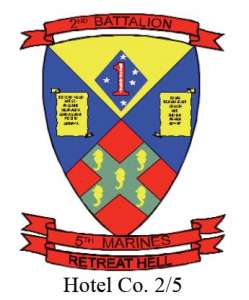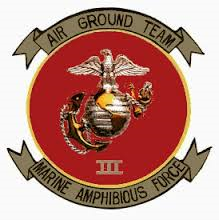Click on which chronology you wish to review. What is a Marine Chronology?
See the information below.
 United States Marine Corps Command Chronology
United States Marine Corps Command Chronology
The following was extracted in part from Marine Corps Order 5750.1H document, subject: “Manual for the Marine Corps Historical Program”.
-
Objective
The command chronology is a documented report to the Commandant of the Marine Corps covering the significant events of designated Marine Corps organizations. It is retained on behalf of the Commandant of the Marine Corps in the Archives and Special Collections Branch, Library of the Marine Corps. It includes basic material for use by the staff agencies of Headquarters Marine Corps and by field organizations. It provides the reporting command with a periodic summation of its experiences that might be useful for future planning and for the orientation of new personnel. The command chronology is the basic historical record of the character and experience of each Marine Corps organization. Unit histories, lineages, streamer entitlement, and numerous manpower, logistics, and mission-related reports can be developed through reference to this record. Command chronologies are permanent records and, as such, will eventually be retired to the National Archives and Records Administration (paper or digital copies are to be retained by the Archives and Special Collections Branch, Library of the Marine Corps). As these reports are often the only lasting official record of a command’s activities, it is imperative that they be complete, informative, legible, and representative of the professionalism and precision that have traditionally characterized the Marine Corps. To ensure the command chronology truly reflects the command, it must receive the personal attention of the commander and must be signed by the commander rather than “By direction.” Command chronologies not signed by commanding officers will be considered incomplete until the commander or acting commander has signed.
2. Scope
(1) The command chronology will provide a concise review of the experiences of the command for the period covered. The objective is to ensure that the report covers all elements of the command, even those that may be temporarily detached. Occasional duplication of reporting that may result is far preferable to occurrences of unreported activity.
(2) Each command chronology must reflect the specific missions and tasks assigned to the command, the status and readiness throughout the period, and the command goals and accomplishments. The command chronology should be written with future readers in mind, some of whom will be unfamiliar with the personnel, equipment, and mission associated with the command. All acronyms will be written out when used for the first time in the text; complete names, including first name, middle initial, and last name, will be used.
(3) All significant programs and policy decisions adopted or implemented during the reporting period should be fully defined. Changes in facilities, acquisition of new equipment, tests of equipment or doctrine, contributions to the evolution of doctrine, and problem areas should also be included in the report.
(4) The command chronology must be presented in sufficient detail to convey the unique and distinctive qualities of the command during the period covered.
3. Format
Format and detailed instructions for the preparation of command chronologies are contained in Appendix A of Marine Corps Order 5750.1H “Manual for the Marine Corps Historical Program. The form and content of chronologies may vary somewhat with the functions of the reporting organization. Each chronology, however, will include the four standard sections discussed below.
(1) A standard first page, containing organizational data prepared in the format shown in Annex 1 of Appendix A.
(2) A narrative summary written from the commander’s viewpoint, highlighting the most significant accomplishments of the unit and discussing the approaches and techniques used to overcome problems. Emphasis should be given to recurring problems.
(3) A sequential listing of significant events in the format shown in Annex 3 of Appendix A, especially as they relate to:
(a) Combat operations/actions with specific dates.
(b) Activation, deactivation, and redesignation of units within the organization, and the specific dates such events took place.
(c) Changes of operational and administrative control, and relocations, including specific dates (primarily organizations of the operating forces).
(d) Alerts, deployments, and landing/training exercises (primarily organizations of the operating forces).
(e) Significant command and staff actions.
(f) Command relations with other military organizations within the immediate area (e.g., area coordination relationships, significant joint and/or combined agreements) (primarily organizations of the operating forces).
(g) Modifications to plant and facilities (primarily non[1]operating force organizations).
(h) Ceremonies and awards.
(i) Civic action and community relations highlights.
(4) The fourth section of the command chronology is made up of supporting documents, as illustrated in Annex 4 of Appendix A. Documents will be included whenever needed for clarity and completeness, or to preclude lengthy writing. Both the narrative section and the sequential listing of significant events can be amplified by documents. Cross-referencing should be accomplished throughout these sections (e.g., by inserting such phrases as “See Letter of Instruction and After Action Report, Items #6 and #7 in Section IV”). At a minimum, complete documentation (i.e., a complete Section IV) must be included with the original copy, and with the copy that becomes a part of the unit’s historical summary file. Widely circulated documents known to be available may be referenced in copies of the chronology that are intended for intervening echelons. Electronic documents and records, even those never designed for printing should be included as part of the supporting documentation. Documents of the following types must be included.
(a) After-action reports, unit special reports, and unit peacetime exercise reports.
(b) Policy directives; standing operating procedure directives, unit orders, bulletins, and memoranda.
(c) Operation and administrative plans and letters of instruction.
(d) Journals, messages, and periodic reports of staff sections or subordinate units, including important e-mail traffic.
(e) Aviation combat reports.
(f) General and special staff studies and estimates.
(g) Cruise books, terrain sketches, photographs, maps, copies of combat art, blueprints, and drawings. These must be identified or captioned fully and dated.
(h) Field oral history interviews, copies of unit/commander’s web pages and/or logs, and web-based or e-mail newsletters.
(i) Other documents of historical significance.
d. Clearance and Limitation Designations. All Marine Corps histories are written as unclassified documents.



